Making Quince Jam
Posted by Andrea Bellamy on Monday, February 18th, 2008Tags for this Article: heavy-petal, how-to-make-quince-jam, quince-jam, quince-jelly

We’re welcoming a new contributor to In The Kitchen: Andrea Bellamy. Andrea runs Heavy Petal, a blog devoted to “Gardening: from a west coast urban organic perspective”. The following article is reproduced from her blog, but since I’m the one who made the jam with her, I figured rather than write my own post on this, it would be an ideal time to coerce her into joining us here on our food adventures. (Ben)
This is a quince fruit, in case you’re not familiar with them (as I wasn’t prior to this past weekend). They are lumpy and somewhat pear-shaped, with fuzz almost like you’d find on a peach. Generally considered inedible when raw due to their sour taste, they smell divine, however – all sweet and perfume-like – which makes sense when you consider the quince tree, Cydonia oblonga, is from the family Rosaceae. Here are a bunch of yummy-sounding quince recipes, should you find yourself with a surplus of quince but no desire to can.
One thing I didn’t mention in my review of Animal, Vegetable, Miracle is how it has inspired me to try my hand in the kitchen. As I may have mentioned, I don’t really like to cook. I live with a man who is practically a Michelin-starred chef (or would be, if they visited our place for dinner) so why even try? But Animal, Vegetable, Miracle really made me reconsider my stance. I’m not even really sure why — it expounds local eating, but no where does it say, “And make it yourself!” Although I guess that’s kind of implicit in a slow-food love poem, anyway.
Which brings me to how I ended up with 10lbs (4.5kg) of quince. Ben and I were at the farmer’s market on the weekend when we saw boxes of the unsightly-looking fruit. We’d never bought quince before. In fact, the only reason we even paused was that when we were in France last May, we stayed at Le Manoir de la Maison Blanche in Amboise, where they served delicious homemade jams with our breakfast baguette. One of the jams, of course, was quince.
Memories of France, combined with my new commitment to local eating (and cooking!) somehow convinced me that buying mountains of quince was a good idea. We would make jam. It would be fun, and the results would be delicious. I could be one of those (increasingly few) people who brought a jar of homemade jam when dropping in for a visit. Nevermind that the only thing I knew about jam-making was based on a novel called Blue Jelly (subtitled “Love Lost and the Lessons of Canning”). But, I thought, how hard can it be? My grandpa used to pickle eggs. Surely jam was easier.
I don’t know about eggs, but jam was easy. And we haven’t died of botulism. Yet. Here’s how we did it:
Quince Jam
5 lbs of quince + sugar to taste (about 2 cups) + water + 1 tbsp lemon juice = YUM
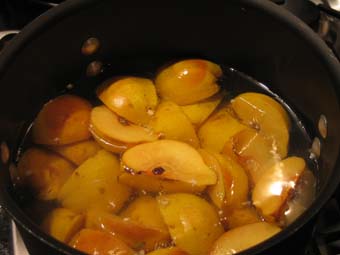
We scrubbed the quince, then chopped it into quarters, leaving the cores intact. Apparently the cores have a lot of natural pectin (a good thing, since it contributes to “jelling” or setting). Then we boiled them for 20 minutes in just enough water (sorry, that’s not very specific. I guess they were covered by about an inch or two of water).

We drained the liquid, saving it to make quince jelly. (I love that you can make two products in one go!) Then we removed the cores from the still-hot fruit and chucked it into the food processor.
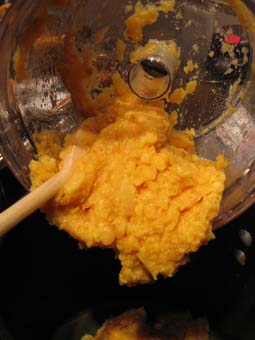
After blending until it was the consistency of chunky applesauce, the whole lot went back into the pot, along with two cups of the saved quince liquid, about two cups of sugar, and a tablespoon of lemon juice.
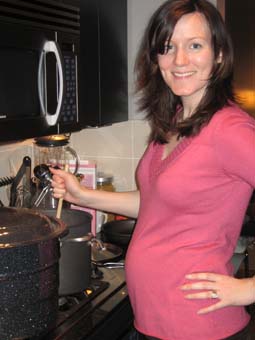
At this point, I was feeling like a bit of a homesteader (perhaps a tad hyperbolic – but I’m a city gal, and canning is so old school). Ben took this photo of me barefoot, pregnant, and slaving over a hot stove. Except I’m not barefoot. I’m stirring. And stirring. You’ve got to keep the fruit moving, lest it brown and stick to the pot. Bring the fruit to a boil and let ‘er rip for about 20 minutes, or until the setting point is reached.
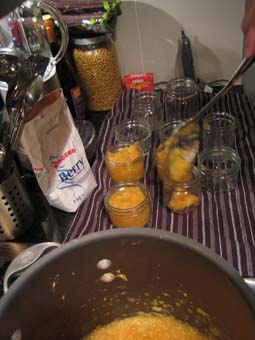
Next, we spooned the fruit into sterilized jars, threw some lids and rings on, and then boiled the jars in my mom’s old canning pot for 10 minutes.
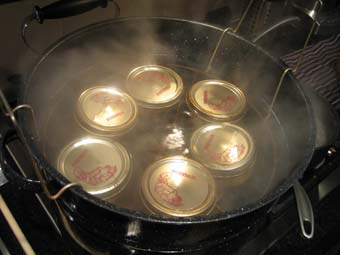
Next, we spooned the fruit into sterilized jars, threw some lids and rings on, and then boiled the jars in my mom’s old canning pot for 10 minutes.
The result: eight jars of lovely, thick quince jam. Invite me around for tea and I might just bring you a jar.

